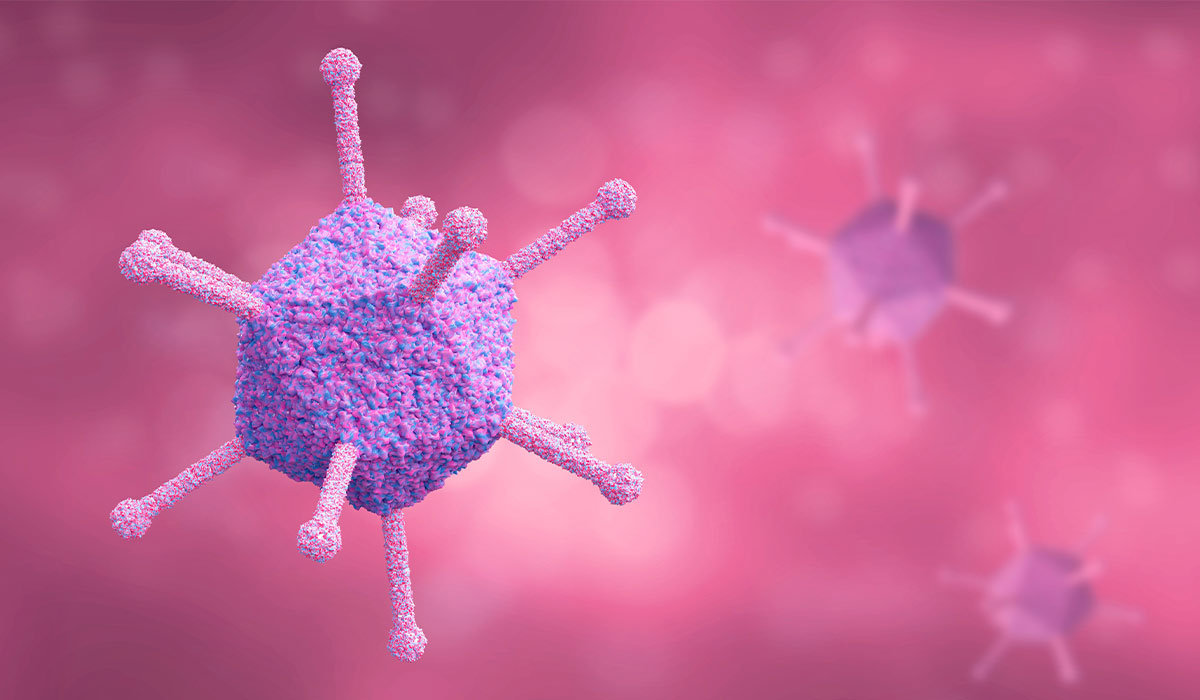Influenza is a severe viral illness that should never be underestimated. The flu virus spreads through droplets and is commonly contracted from direct contact with an infected person or inhaling microdroplets of their respiratory secretions.
An adult infected with the influenza virus can infect others within 3-5 days of the onset of influenza symptoms, while a child suffering from influenza is a source of infection for up to seven days (usually up to 3 days after the fever subsides).
The flu symptoms are very intense. It develops rapidly – the patient's condition deteriorates within a few hours. People who feel relatively well in the morning have a high fever and severe muscle pain in the evening.
The severity of flu symptoms distinguishes it from the common cold and other viral infections.
Despite the similar clinical picture, there are several differences:
Diagnosis of influenza virus is necessary in hospitalized patients who develop complications of influenza, e.g., pneumonia.
Flu symptoms![]() appear suddenly and are very intense – their intensity is characteristic of this disease.
appear suddenly and are very intense – their intensity is characteristic of this disease.
Influenza symptoms include:
Additional, no less troublesome signs often accompany the main symptoms of influenza:
During the first 4-5 days of flu, patients have most of the symptoms listed above. After some time, headache, high fever, and cough (which changes from a dry to a wet cough) may also be accompanied by pain in the eye sockets and photophobia.
Flu symptoms should start to subside after 5-7 days: fever drops and headache subsides. Other symptoms are also slowly becoming less troublesome. But you should not get out of bed immediately and try to return to your daily activities or work: flu treated too briefly or poorly treated can give serious complications, so you need to stay at home for up to 2 weeks.
Influenza is caused by influenza viruses belonging to the family Orthomyxoviridae![]() , which multiply in the epithelium of the respiratory tract.
, which multiply in the epithelium of the respiratory tract.
Influenza viruses are transmitted![]() :
:
It is worth knowing that epidemiologists divide influenza into two types: seasonal and pandemic. Seasonal flu![]() occurs each year during the epidemic period (usually from September to April) and is most often caused by viruses of the H1N1 or H3N2 subtypes.
occurs each year during the epidemic period (usually from September to April) and is most often caused by viruses of the H1N1 or H3N2 subtypes.
Pandemic flu![]() , in turn, can be caused by other subtypes of the virus. Due to the lack of immunity, the infection spreads very quickly, which is why there are many more patients than in the case of seasonal flu – then we are talking about a global epidemic, or a pandemic (e.g., Spanish flu pandemic) that occurs every few decades.
, in turn, can be caused by other subtypes of the virus. Due to the lack of immunity, the infection spreads very quickly, which is why there are many more patients than in the case of seasonal flu – then we are talking about a global epidemic, or a pandemic (e.g., Spanish flu pandemic) that occurs every few decades.
If the doctor – based on the symptoms – suspects the patient has influenza, he should refer the patient for tests that will confirm or exclude influenza. Influenza tests are based on:
The most commonly used flu tests![]() are:
are:

Due to the risk of dangerous complications![]() of influenza, you should not treat it yourself, let alone try to “pass” it. Depending on the age, general health of the patient, and possible chronic diseases, the doctor should indicate the best treatment.
of influenza, you should not treat it yourself, let alone try to “pass” it. Depending on the age, general health of the patient, and possible chronic diseases, the doctor should indicate the best treatment.
If they say there are no serious risks, the specialist will only recommend flu relief and rest. In case of suspicion of influenza, we should call the doctor at home so as not to go to the clinic and not to expose others to the disease.
Symptomatic flu treatment![]() includes:
includes:
In people from high-risk groups – it is recommended to treat influenza with new-generation drugs, i.e., antiviral and anti-influenza drugs![]() . These are neuraminidase inhibitors active against viruses A – whose task is to block the multiplication of the virus. For these medications to work properly, they need to be taken within 48 hours of the start of flu symptoms. Before administering drugs from this category, it is necessary to conduct a test to confirm that the patient has influenza.
. These are neuraminidase inhibitors active against viruses A – whose task is to block the multiplication of the virus. For these medications to work properly, they need to be taken within 48 hours of the start of flu symptoms. Before administering drugs from this category, it is necessary to conduct a test to confirm that the patient has influenza.
Flu and its associated symptoms can last from 3 to 7 days. In some cases, the disease can last up to 2 weeks from the onset of the first symptoms. Its duration depends on the strain of the virus, the immune system, and the severity of the ailments.

A person suffering from influenza should as soon as possible go to the hospital if they have the following symptoms:
Complications of influenza usually appear in all patients. The special risk group![]() includes:
includes:
Complications of the flu![]() include:
include:
It may also lead to the exacerbation of chronic diseases – for example:
Influenza in children![]() is one of the most common viral respiratory diseases. The disease is caused by the influenza virus, which causes troublesome symptoms, including fever. Parents always ask how long flu fever lasts in children. In the case of the flu, it usually lasts a few days. There are other troubling flu symptoms in children as well.
is one of the most common viral respiratory diseases. The disease is caused by the influenza virus, which causes troublesome symptoms, including fever. Parents always ask how long flu fever lasts in children. In the case of the flu, it usually lasts a few days. There are other troubling flu symptoms in children as well.
In this case, home remedies for the flu in children will not help. It is necessary to see a doctor who will prescribe flu medicine for children. Otherwise, severe complications may occur.

The cause of the disease![]() is influenza A or B virus. The disease is transmitted by droplets. That is why it can be easily transmitted by direct contact with a sick person and by touching objects belonging to the infected person.
is influenza A or B virus. The disease is transmitted by droplets. That is why it can be easily transmitted by direct contact with a sick person and by touching objects belonging to the infected person.
People who are particularly at risk of infection include children because their immune systems are still immature. They are also at a high risk of developing post-influenza complications – this applies especially to children with immune disorders or chronic diseases.
The child's immune system is immature – so the infection course can be much more severe than in adults. In addition, an adult is contagious for five days after symptoms disappear. The child can be contagious for ten days or more (up to three days after the fever is gone).
Early flu symptoms in children![]() include:
include:
Next, it combines with the symptoms related to the respiratory system:
Gastrointestinal symptoms may also occur, such as:
It usually takes about two weeks for a complete recovery.
Diagnosis![]() is usually made based on symptoms. To be sure, tests based on molecular biology tests or rapid immunofluorescence tests can be performed.
is usually made based on symptoms. To be sure, tests based on molecular biology tests or rapid immunofluorescence tests can be performed.
Treatment of influenza in children![]() consists in relieving the symptoms of the disease. Flu medicines for children are antipyretics and painkillers. Depending on the accompanying symptoms, the doctor may also recommend antitussives (cough medicines for children in the form of syrup or gel) or medicine soothing rhinitis.
consists in relieving the symptoms of the disease. Flu medicines for children are antipyretics and painkillers. Depending on the accompanying symptoms, the doctor may also recommend antitussives (cough medicines for children in the form of syrup or gel) or medicine soothing rhinitis.
It is also important to properly hydrate the child (e.g., warm teas with honey and lemon, and natural fruit juices). In addition, a patient needs a lot of sleep and rest. You should also ventilate the room frequently.
It is important to remember that we do not treat influenza with antibiotics. The doctor may prescribe it when he suspects an additional bacterial infection or prophylactically – to prevent complications.
Influenza can be prevented – and it is worth it not only because of the severe course of this disease but also because of its possible complications.
The best flu prevention methods are:
Table of Contents

Bird flu is a disease that rarely affects humans these days. However, it is still possible to become infected. Learn… read more »

Epstein Barr Virus is a pathogen that causes infectious mononucleosis and many other diseases. Learn about the risks associated with… read more »

The Ebola virus continues to pose a threat to those living in Africa. Learn about the risks associated with Ebola… read more »

Discover Sore Throat Remedies for quick and effective pain relief. Many herbs and foods have healing properties. Learn how to… read more »

Croup is a common respiratory disease It is often seen in children under the age of 5 years. Learn about… read more »

West Nile Virus is a threat not only to Africans. Fortunately, most patients pass the infection mildly, but there are… read more »

Viruses are microscopic infectious agents that can only replicate inside the living cells of a host organism. They are not… read more »

Strep throat is a bacterial infection that affects the throat and tonsils. Around 11 million people are infected with this… read more »

A viral infection occurs when a virus invades the body and begins to multiply. Viruses are tiny infectious agents that… read more »